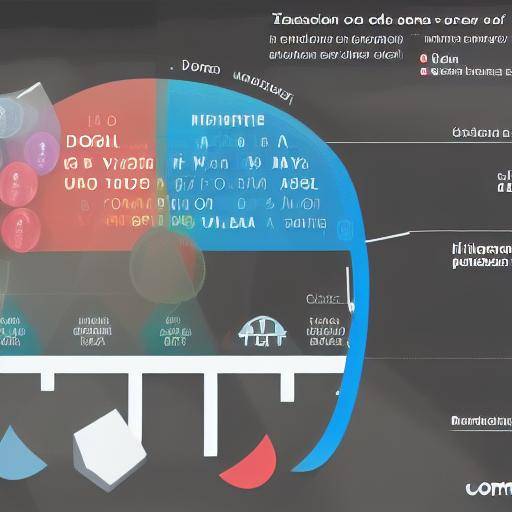
In decision-making, especially in business and financial environments, risk management plays a crucial role. Risk analysis, known for its importance in assessing and mitigating potential drawbacks, directly affects strategic decisions taken in organizations and projects. In this article, we will explore in depth the impact of risk analysis on decision-making, addressing its historical importance, its application in different contexts, and offering practical advice and expert perspectives to better understand this fundamental process.
Introduction
When it comes to decision-making, understanding and evaluating associated risks is essential to making informed and strategic decisions. Risk analysis provides a structured framework for identifying, evaluating and mitigating the risks that may affect the desired results.
History and Background
Risk analysis has its roots in ancient Chinese civilization, where it was used to evaluate different situations and make informed decisions. Over time, this approach expanded to other cultures and developed in different disciplines. In the business context, risk analysis began to gain greater relevance as organizations faced an increasingly complex and competitive business environment.
During the twentieth century, risk management became an independent field of study, with the development of formal theories and approaches to assess and mitigate risks in different scenarios. The implementation of these methodologies in business decision-making demonstrated their positive impact, leading to more widespread adoption.
This approach has evolved considerably with the advent of advanced technologies and access to large volumes of data. Risk analysis has become an invaluable tool for businesses, governments and non-profit organizations, ranging from financial management to cybersecurity.
Analysis in Deep
Risk analysis provides a number of tangible benefits for organizations. In identifying and evaluating potential risks, companies can make more informed decisions, anticipate potential obstacles and develop effective contingency plans. In addition, risk analysis helps to protect the company's assets, improve operational efficiency and ensure compliance with regulations and standards.
However, there are also challenges associated with risk analysis, such as the difficulty in quantifying certain risks, the impact of uncertainty and the need for continuous updating of data. Despite these challenges, risk analysis remains a vital tool for effective decision-making.
Exhaustive examination
Applying risk analysis in decision-making is critical in situations ranging from financial investments to the implementation of new projects. Leading companies use risk analysis as an integral part of their decision-making process, allowing them to minimize negative impacts and capitalize on opportunities.
Various industries, such as banking, insurance, project management and the health industry, rely heavily on risk analysis to guide their strategies and operations. The use of advanced models, predictive analysis and artificial intelligence have further expanded the capabilities of risk analysis, providing greater accuracy in risk assessment and management.
Comparative analysis
When analyzing the concepts of "risk analysis", "take of decisions" and "risk management", it is important to recognize their similarities and differences. While risk analysis focuses on identifying and evaluating potential risks, decision-making involves selecting the most appropriate action among several alternatives. On the other hand, risk management includes planning and implementing strategies to mitigate and control identified risks.
Although these concepts are interrelated, each addresses specific aspects of decision-making in complex and changing contexts. By understanding the subtleties of each approach, organizations can improve their ability to effectively manage risks and make informed decisions.
Practical Tips and Accessible Advice
In implementing risk analysis in decision-making, it is important to follow certain practical advice. These include:
- Identify and evaluate potential risks systematically.
- Use quantitative data and analysis to support decision-making.
- Incorporate risk management as a continuous process in strategic planning.
- Develop effective contingency plans to address potential adverse scenarios.
By following these tips, organizations can improve risk management and optimize their decision-making processes, which helps them achieve their goals more effectively.
Ideas and Industry Reviews
The perspectives of experts and industry leaders provide valuable information on the impact of risk analysis on decision-making. According to risk management experts, the integration of emerging technologies, such as predictive analysis and artificial intelligence, is transforming how risks are addressed in business and financial environments.
There is also a growing trend towards a more proactive approach to risk management, where organizations seek to anticipate and mitigate risks before they become serious problems.
Case Studies and Practical Applications
Case studies illustrate the concrete application of risk analysis in different scenarios, providing a real context and practical perspectives. For example, in the health sector, risk analysis is used to assess patient safety, anticipate possible complications and ensure quality of care. In the financial sphere, financial institutions use risk analysis to assess client solvency and minimize credit risk.
Future Trends and Predictions
Looking ahead, it is clear that risk analysis will continue to play a key role in strategic decision-making. With the advancement of technology, analytical and predictive capacities are expected to continue to improve, allowing a more accurate assessment of emerging risks and opportunities.
In addition, growing awareness of the importance of risk management at all levels of an organization will boost the integration of more robust and comprehensive risk analysis processes in everyday decision-making.
Conclusions
In short, risk analysis has a significant impact on decision-making, as it provides a deeper understanding of the potential risks and opportunities that influence results. By carefully considering the risks involved, organizations can make more informed and effective decisions, mitigating negative impacts and capitalizing on emerging opportunities.
As the business environment continues to evolve, risk analysis will play an increasingly crucial role in decision-making, helping organizations to successfully navigate on complex scenarios and achieve their strategic objectives.
Frequently asked questions
Why is it important to conduct a risk analysis in decision-making?
Risk analysis is critical because it allows to identify and evaluate the potential obstacles and opportunities associated with a decision, which provides a clearer and more informed view for informed decision-making.
What are the main challenges associated with risk analysis?
Some challenges include the difficulty of quantifying certain risks, the uncertainty inherent to certain scenarios and the need for a continuous updating of data to maintain the effectiveness of risk analysis.
How is risk analysis integrated in decision-making in the financial sector?
In the financial sector, risk analysis is used to evaluate customer solvency, manage credit risks, and make informed investment decisions, which helps protect assets and optimize financial operations.
What is the role of risk management in strategic decision-making?
Risk management involves developing strategies to mitigate and control risks identified during the analysis, ensuring that strategic decisions are supported by a comprehensive assessment of associated risks.
How has risk analysis evolved with the advancement of technology?
Technological advance has allowed a more accurate, predictive and contextualized analysis of risks, integrating advanced analytical capabilities and improving the management and interpretation of large volumes of data.
What future trends are expected in risk analysis and decision-making?
Future trends include a more proactive approach to risk management, the integration of emerging technologies such as artificial intelligence, and increased awareness of the importance of risk management at all organizational levels.
How can organizations improve their implementation of risk analysis in decision-making?
Organizations can improve their implementation of risk analysis by adopting more holistic and integrated approaches, using advanced technologies, and promoting an organizational culture focused on proactive risk assessment and management.
With this we conclude, we hope that this article has provided a deeper understanding of the fundamental impact of risk analysis on decision-making. By effectively integrating this approach, organizations can optimize their capacity to manage risks and make informed strategic decisions.




































